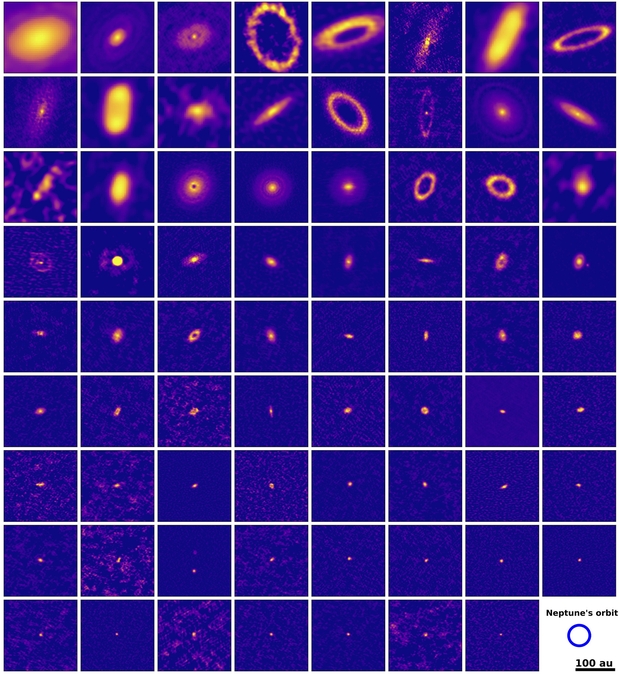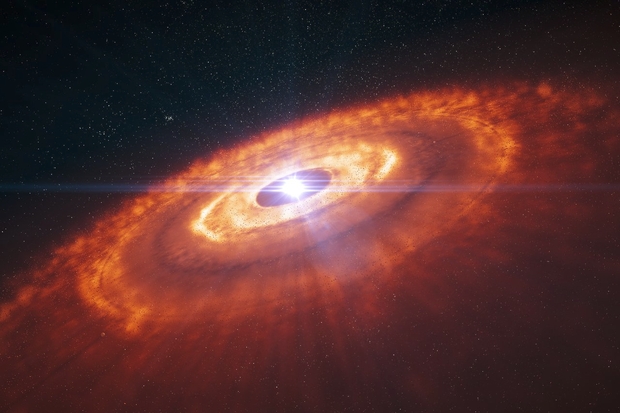In astronomy, the first thing you see may be the least typical. A case in point: ‘Hot Jupiters.’ A few prescient souls, among them Buzz Aldrin and John Barnes in their novel Encounter with Tiber, speculated about gas giants that survived incredibly tight orbits around their star, and when asked about this in the 1990s, Greg Matloff ran the numbers and confirmed to his surprise that there was a theoretical case for their existence. Let me quote Matloff on this:
Although I was initially very skeptical since then-standard models of solar system formation seemed to rule out such a possibility, I searched through the literature and located the appropriate equation (Jastrow and Rasool, 1965)….To my amazement, Buzz was correct. The planet’s atmosphere is stable for billions of years. Since I was at the time working as a consultant and adjunct professor, I did not challenge the existing physical paradigm by submitting my results to a mainstream journal. Since “Hot Jupiters” were discovered shortly before the novel was published, I am now credited with predicting the existence of such worlds.
51 Pegasi b made the case for ‘hot Jupiters’ convincingly in 1995, and we also know that the reason we began finding these planets was that our best methods for detecting exoplanets in the mid-1990s involved radial velocity and transit measurements, both of which are most effective when dealing with large planets in close orbits. As best I can determine, current estimates find a scant ~0.5–1% of these planets around F-, G-, or K-class stars. The rarity of hot Jupiters like TOI-4201b underlines how rare these objects are around M-dwarfs.
Observational bias can be a tricky thing. So is something of the same phenomenon occurring in our study of how planets form? Protoplanetary disks are extensively studied, some of them showing what appear to be planets in their early stages of formation. As I’ve read studies about disks like those at TW Hydrae and HL Tauri, I’ve always assumed that they were massive. In some cases they extend far beyond our Solar System’s outer reaches. But now we have a new study making a strong case that disks like these are not typical.
The work in question involved data from ALMA, the Atacama Large Millimeter/submillimeter Array. It comprises data from observations from 2023 and 2024 at resolutions of 0.030 arcsecond, along with somewhat higher resolution archival data to produce a high resolution survey of an entire star-forming region. The imaging takes in all known protoplanetary disks around young stars in the Lupus star forming region, some 400 light years from Earth.
The results indicate how much we have to learn about protoplanetary disks. The smallest disk comes to only 0.6 astronomical units in radius, which means it is smaller than the Earth’s orbit. The researchers also learned that the kind of features that point to planets in formation do not occur in smaller disks. Thus lead author Osmar M. Guerra-Alvarado (Leiden University, The Netherlands):
“These results completely change our view of what a ‘typical’ protoplanetary disc looks like. Only the brightest discs which are the easiest to observe show large-scale gaps, whereas compact discs without such substructures are actually much more common.”

Image: Images of 73 protoplanetary discs in the Lupus star forming region (two of the images contain binary stars). Only a fraction of the discs extend beyond the orbit of Neptune, when compared to our own Solar System. Most of the observed discs are small and show no structures like gaps and rings. (c) Guerra-Alvarado et al.
Adds Leiden colleague Nienke van der Marel:
“The discovery that the majority of the small discs do not show gaps, implies that the majority of stars do not host giant planets. This is consistent with what we see in exoplanet populations around full-grown stars. These observations link the disc population directly to the exoplanet population.”
The smaller protoplanetary disks are found around stars massing between 10 and 50 percent of the mass of the Sun. While disks like these do not appear optimum for the formation of gas giants, they may be fertile breeding ground for super-Earths, with most of the dust located close to the host star. Given this context, our own Solar System may have been formed from a more massive protoplanetary disk large enough to produce a Jupiter and a Saturn.

Image: This is an artist’s impression of a young star surrounded by a protoplanetary disc in which planets are forming. Using ALMA’s 15-kilometre baseline astronomers were able to make the first detailed image of a protoplanetary disc, which revealed the complex structure of the disc. Concentric rings of gas, with gaps indicating planet formation, are visible in this artist’s impression and were predicted by computer simulations. Now these structures have been observed by ALMA for the first time. Note that the planets are not shown to scale. Credit: ESO/L. Calçada.
From the paper:
The fact that we observe numerous compact disks in the Lupus region, both with and without substructures, aligns with the scenario from van der Marel & Mulders (2021), in which such disks, undergoing significant radial drift, can supply enough dust material to form multiple super-Earths (Sanchez et al. 2024). This offers a potential explanation for the origin of the exoplanet populations observed around M-stars to this day. In addition, the fact that we are still observing these disks may require something to halt dust drift and trapping particles. Instead of forming a single Jupiter or Saturn-mass planet, several super-Earths or smaller planets may be forming in the inner regions of these disks, collectively stopping the drift (Huang et al. 2024b).
So we have to look at the question of observation bias once again. As with hot Jupiters, our best methods continue to improve, and as they do, we gradually form a broader picture of the phenomena being studied. In the case of the latest ALMA work, we are delving into higher-resolution measurements that can begin to tease out information about small disks that have previously been studied only in terms of brightness as opposed to size. A ‘typical’ disk turns out to be something other than the large, bright disks first revealed by ALMA.
The paper is Guerra-Alvarado et al., “A high-resolution survey of protoplanetary discs in Lupus and the nature of compact discs,” Accepted for publication in Astronomy & Astrophyiscs (preprint).



How Many Rogue Planets Are There in the Milky Way?
New simulations suggest that many, if not most, planets are ejected from their stars early in their formation.
https://www.scientificamerican.com/article/how-many-rogue-planets-are-in-the-milky-way/
https://arxiv.org/pdf/2501.13166
This raises the question: How many of these rogue planets might be habitable? Super-Earths, for example, could generate enough internal heat and possess a sufficient atmosphere to insulate these wandering planets, allowing for the possibility of life to evolve. Large eyes would be a real asset on these nocturnal worlds…
I am not surprised, I think once the inner planets have formed the interaction between them, outflowing gas and dust throws them out further so the system looks bigger than they are.
It’s a bit unfortunate the paper does not explicitly give statistics versus the host star mass (I’ve only skimmed it so apologies if I’ve missed this).
I guess we have to assume that disk size scales with host star mass?
My query or concern to KB’s above. When stars are considered “born” the majority turn out to be red dwarfs ranging from about 0.2 to 0.1 solar mass. And their luminosity on the main sequence is another decade lower, 0.08 to 0.01 solar luminosity. So, unless red dwarfs have an unusual amount of fireworks during formation, there might be some consistency in scaling.
Another factor that might populate the sky with faint early star systems is the duration of the formation process. If there is less mass, then the orbital rates near the star node will be reduced too. I hesitate to say that collapse into nuclear ignition is slower, but it should be considered a possibility.
So, it could be that what we are observing here is in accordance with scale. And that a G star like ours would be represented by something like what appears in the upper rows.
Reading of this report earlier, there was some reference to Kuiper Belts. Well, maybe. Assuming that the images are all to the same scale, one would wonder which illuminated rings would span regions in accord with the Kuiper Belt or Oort Cloud here. But in the case of our solar system, I would assume that Oort cloud would be fairly pristine in composition due to its distance from the mixing and
radiation. But the Kuiper Belt would have experience some re-working, that which had not been dropped onto planets.
If to the same scale, these several dozen images should be a good reference for years to come for mapping out what happens in planetary system formation.
Not just as a snap shot, but as a chart showing differences in development before and after.
I remember seeing the results of early simulations – using software originally created by Stephen H. Dole in the 1960s – that showed massive planets forming close to the primary. I thought it was due to the assumptions and simplicity of the software, but maybe it was somewhat accurate. It also generated mini-Neptunes.
A variation of the software (Acrete) is still available, with a brief history:
https://github.com/zakski/accrete-starform-stargen
@Paul – It would be great to read about Dole; he was either born too soon or just at the right time to generate some of the seminal work in exoplanets.
Yes, Dole makes for a good article. His early work was a major influence on me. I’ll put that in my plans.
I see there is expected to be a hunt for hot Jupiters spiralling into their stars under gravitational and magnetic influences. This makes me wonder: how dramatic would the effect of this be on an Earthlike planet in the same system? There’s a popular sci-fi trope of people evacuating from supernovae, but could an event like this also drive a culture to take desperate measures SETI might detect, such as loud broadcasts or clear technosignatures?
I guess the effects would be almost just as extreme, with luminosity of central star increasing some orders of magnitude and then remaining elevated for months to years. It strongly depends on properties of the star and the plunging planet. Sunlike stars would swallow whole everything denser than a rock. M-dwarfs would rip everything apart by tidal forces, including lighter BDs, leading to slower accretion. But explosive spilling-out of the compressed interior of a hot jupiter, after Roche-lobe overflow, would also be very bright.
Also the timing and effects of the inspiral of a hot jupiter/neptune/terrestrial are predictable millions of years before it, with increasing precision, so a civilization would know just as soon as it reaches modern-like level. That would be massive “we are not at all typical, and we are doomed” realisation.
Even more interestingly, collisions of smaller objects would also have observable and even dangerous effects, while they are much less predictable. A Ceres-sized object, coming from nowhere out of local Kuiper belt, heading for a direct plunge in half-century, would amount to 2e32 Joules of collisional energy, equivalent of a week of total solar output. Much of it would radiate out during the first hour, mainly in UV, increasing brightness tens of times, igniting everything on the dayside of local habitable world. That would be even greater sci-fi setting.
But, judging on absense of fusion marks on outer Galilean moons and the lack of apparent signatures on Kepler data, such collisions are still very rare. Maybe some superflares are actually asteroids plunging into their stars, but it’s hard to tell (I actually spent some time surveying lightcurves but found out that it takes much more scrupulous research to make a proper discrimination, if possible =] )